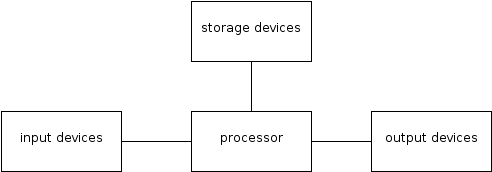
Hardware components are often categorised as being either input, output, storage or processing components. Devices which are not an integral part of the
CPU are referred to as being
peripherals. Peripherals are usually used for either input, storage or output (such as a
hard disk,
keyboard or
printer). A device does not necessarily have to be outside the same physical box as the CPU. The best example of this is the hard disk, which is a peripheral even though it is not usually housed within the main case.
Fig 1: The main hardware components of a computer system
Input devices are hardware devices which take information from the user of the computer system, convert it into electrical signals and transmit it to the processor. The primary function of input devices is to allow humans to interact with the computer system. For instance a
mouse allows the user to control the movement of the pointer (a common element in user interface design).
Output devices take data from the computer system and convert it to a form that can be interpreted by humans. For instance a
monitor creates a visual electronic display to output information created by the processor to the user.
Processing devices are the components responsible for the processing of information within the computer system. This includes devices such as the CPU,
memory and
motherboard.
Computers come in all types and sizes. There are primarily two main sizes of computers. They are:
The portable computer comes in various sizes and are referred to as laptops, notebooks, and hand-held computers. These generally denote different sizes, the laptop being the largest, and the hand-held is the smallest size. This document will mainly talk about the desktop computer although portable computer issues are also discussed in various areas.
Computer Components:
Computers are made of the following basic components:
- Case with hardware inside:
- Power Supply - The power supply comes with the case, but this component is mentioned separately since there are various types of power supplies. The one you should get depends on the requirements of your system. This will be discussed in more detail later
- Motherboard - This is where the core components of your computer reside which are listed below. Also the support cards for video, sound, networking and more are mounted into this board.
- Microprocessor - This is the brain of your computer. It performs commands and instructions and controls the operation of the computer.
- Memory - The RAM in your system is mounted on the motherboard. This is memory that must be powered on to retain its contents.
- Drive controllers - The drive controllers control the interface of your system to your hard drives. The controllers let your hard drives work by controlling their operation. On most systems, they are included on the motherboard, however you may add additional controllers for faster or other types of drives.
- Hard disk drive(s) - This is where your files are permanently stored on your computer. Also, normally, your operating system is installed here.
- CD-ROM drive(s) - This is normally a read only drive where files are permanently stored. There are now read/write CD-ROM drives that use special software to allow users to read from and write to these drives.
- Floppy drive(s) - A floppy is a small disk storage device that today typically has about 1.4 Megabytes of memory capacity.
- Other possible file storage devices include DVD devices, Tape backup devices, and some others.
- Monitor - This device which operates like a TV set lets the user see how the computer is responding to their commands.
- Keyboard - This is where the user enters text commands into the computer.
- Mouse - A point and click interface for entering commands which works well in graphical environments.
These various parts will be discussed in the following sections. | |
|
|
 Hardware components are often categorised as being either input, output, storage or processing components. Devices which are not an integral part of the CPU are referred to as being peripherals. Peripherals are usually used for either input, storage or output (such as a hard disk, keyboard or printer). A device does not necessarily have to be outside the same physical box as the CPU. The best example of this is the hard disk, which is a peripheral even though it is not usually housed within the main case.
Hardware components are often categorised as being either input, output, storage or processing components. Devices which are not an integral part of the CPU are referred to as being peripherals. Peripherals are usually used for either input, storage or output (such as a hard disk, keyboard or printer). A device does not necessarily have to be outside the same physical box as the CPU. The best example of this is the hard disk, which is a peripheral even though it is not usually housed within the main case.




No comments:
Post a Comment